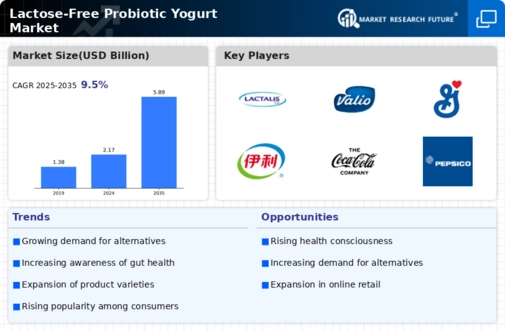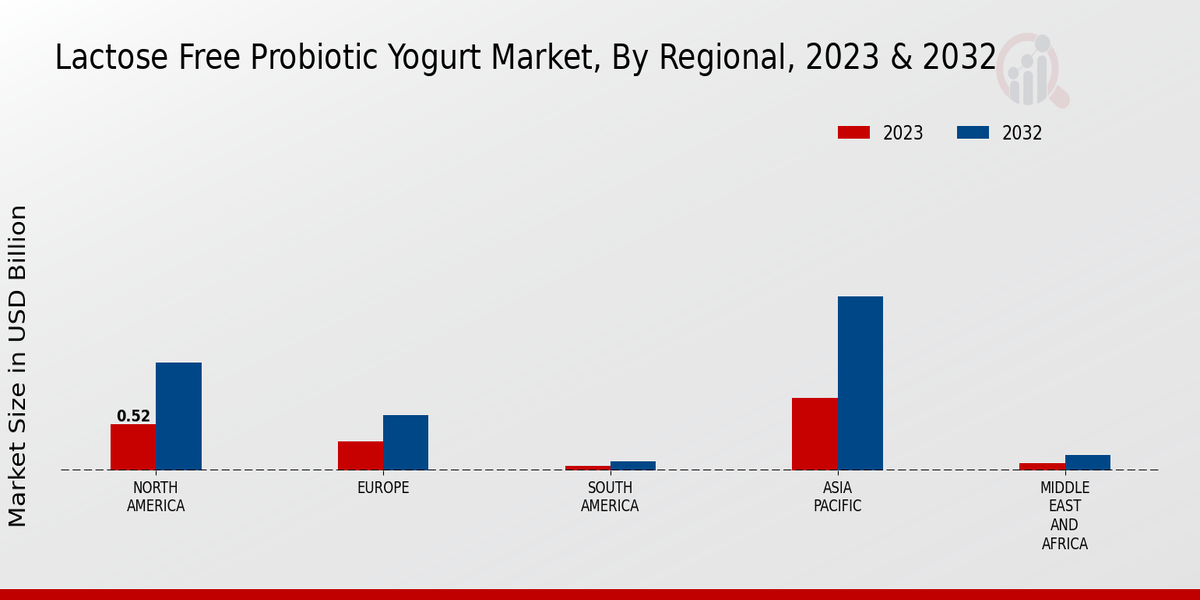Health Consciousness
A growing awareness of health and wellness among consumers significantly influences the Global Lactose-Free Probiotic Yogurt Market Industry. Individuals are increasingly seeking functional foods that offer health benefits, such as improved gut health and enhanced digestion. Probiotic yogurt, known for its live cultures that promote gut flora balance, aligns well with these health trends. This shift towards healthier eating habits is expected to propel the market, with projections indicating a rise to 5.89 USD Billion by 2035. The emphasis on gut health is likely to encourage more consumers to incorporate lactose-free probiotic yogurt into their diets.
Diverse Product Offerings
The expansion of product lines within the Global Lactose-Free Probiotic Yogurt Market Industry is noteworthy. Manufacturers are innovating by introducing various flavors, textures, and formulations to cater to diverse consumer preferences. This includes the development of plant-based lactose-free yogurts, which appeal to vegan and lactose-intolerant consumers alike. Such diversification not only attracts a broader audience but also enhances market competitiveness. As a result, the industry is expected to experience a compound annual growth rate (CAGR) of 9.5 percent from 2025 to 2035, reflecting the positive reception of these innovative offerings.
Market Growth Projections
The Global Lactose-Free Probiotic Yogurt Market Industry is on an upward trajectory, with projections indicating a market value of 2.17 USD Billion in 2024 and a significant increase to 5.89 USD Billion by 2035. This growth reflects the rising consumer demand for lactose-free alternatives and the increasing awareness of health benefits associated with probiotics. The anticipated compound annual growth rate (CAGR) of 9.5 percent from 2025 to 2035 suggests a robust market environment, driven by factors such as health consciousness, product innovation, and enhanced distribution channels.
Rising Lactose Intolerance
The increasing prevalence of lactose intolerance globally drives demand for lactose-free products, including probiotic yogurt. It is estimated that approximately 68 percent of the world's population experiences some form of lactose malabsorption. This condition is particularly common in regions such as Asia and Africa, where the consumption of dairy products is traditionally lower. As consumers seek alternatives that do not compromise their dietary preferences, the Global Lactose-Free Probiotic Yogurt Market Industry is poised for growth. This shift is reflected in the projected market value of 2.17 USD Billion in 2024, indicating a robust response to consumer needs.
Consumer Education and Marketing
Effective consumer education and marketing strategies play a crucial role in shaping the Global Lactose-Free Probiotic Yogurt Market Industry. As consumers become more informed about the benefits of probiotics and lactose-free diets, they are more likely to make informed purchasing decisions. Brands that invest in educational campaigns and transparent labeling can foster trust and loyalty among consumers. This trend is expected to further stimulate market growth, as informed consumers are more inclined to choose lactose-free probiotic yogurt over traditional options. The industry's focus on consumer engagement is likely to contribute to its projected CAGR of 9.5 percent from 2025 to 2035.
Increased Availability in Retail Channels
The accessibility of lactose-free probiotic yogurt in various retail channels contributes to its market growth. Supermarkets, health food stores, and online platforms are increasingly stocking these products, making them more available to consumers. This trend is particularly evident in urban areas where health-conscious consumers actively seek out lactose-free options. The Global Lactose-Free Probiotic Yogurt Market Industry benefits from this increased visibility, as it encourages trial and repeat purchases. Enhanced distribution strategies are likely to support the market's expansion, aligning with the projected growth trajectory towards 5.89 USD Billion by 2035.


















Leave a Comment